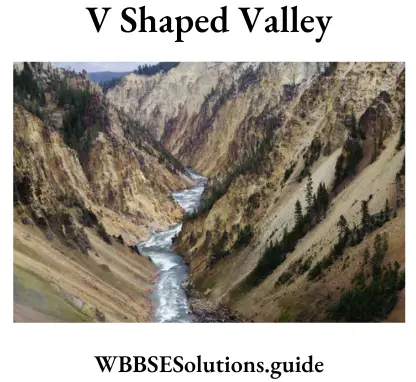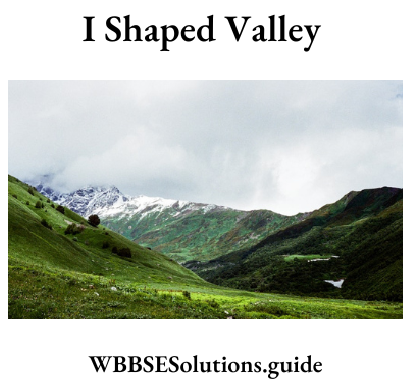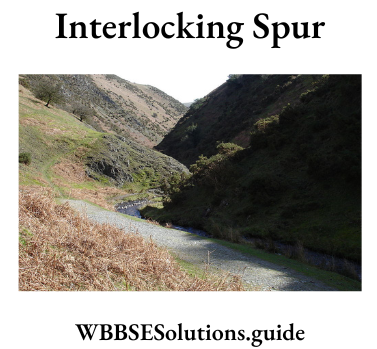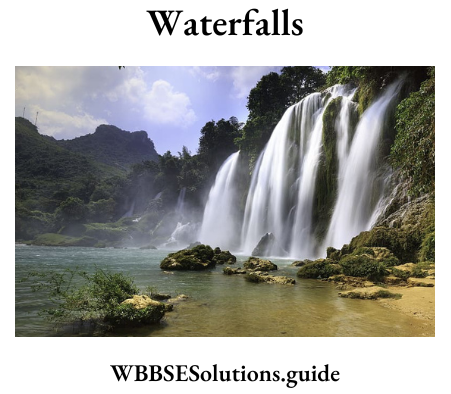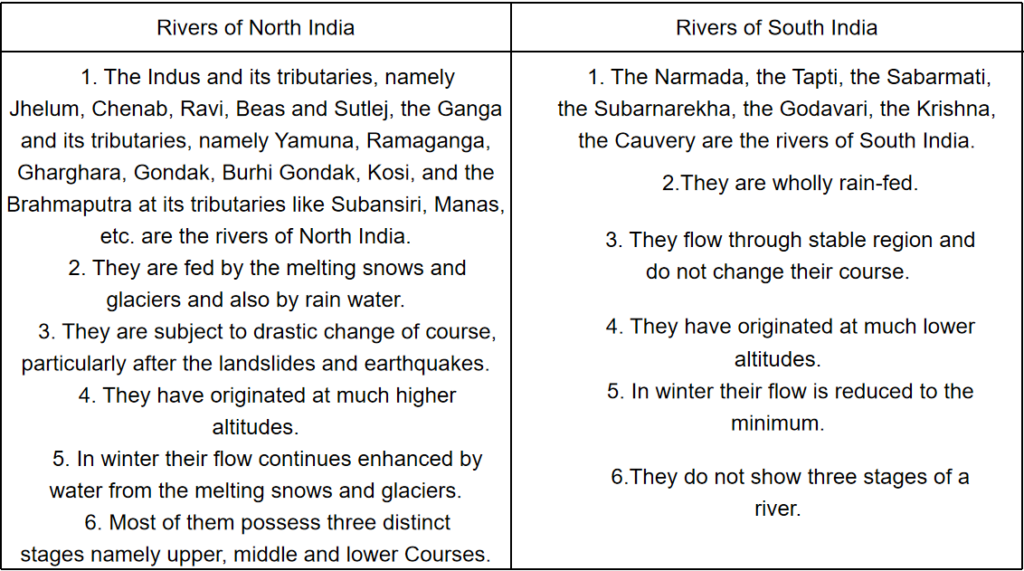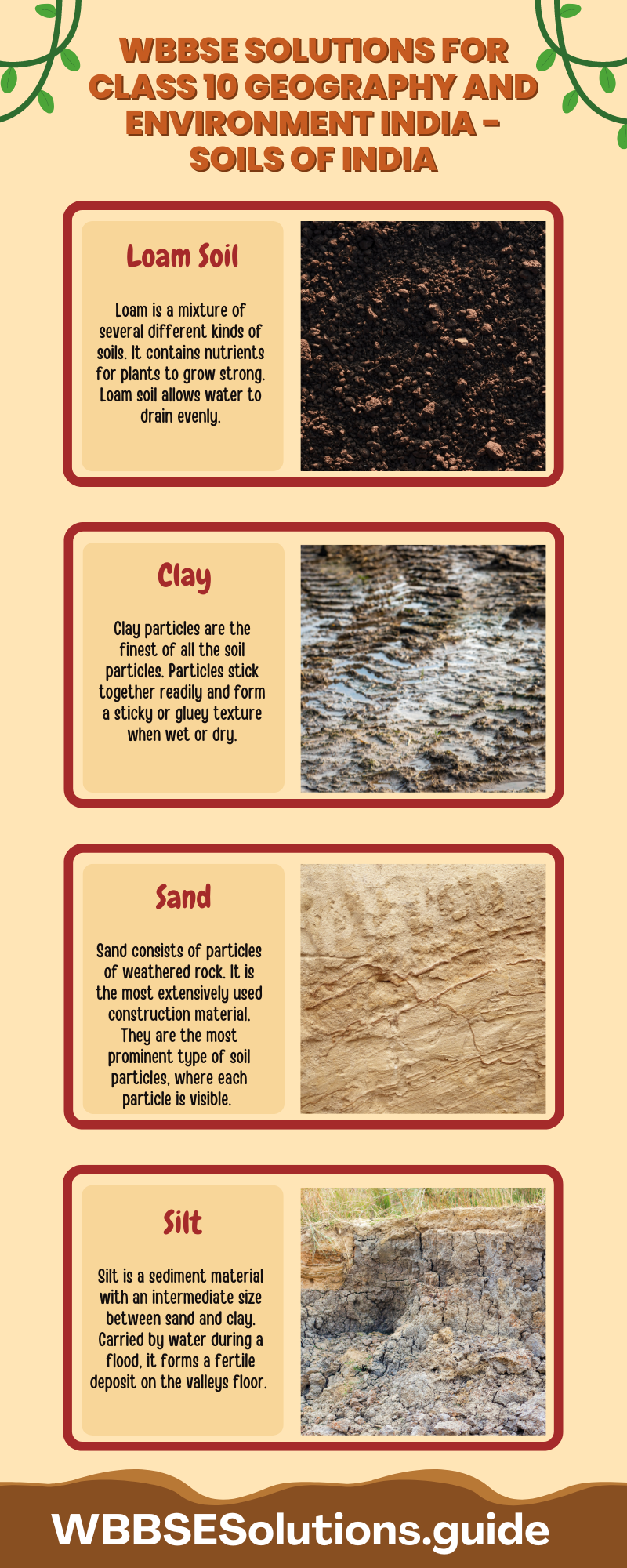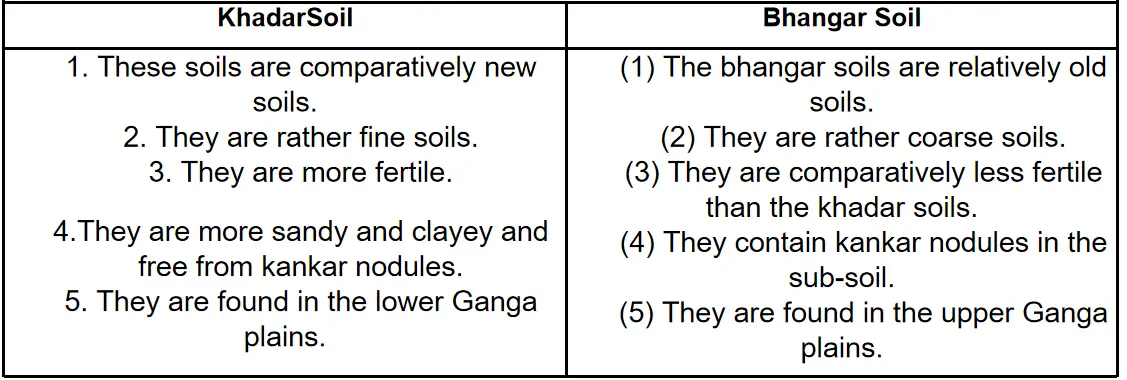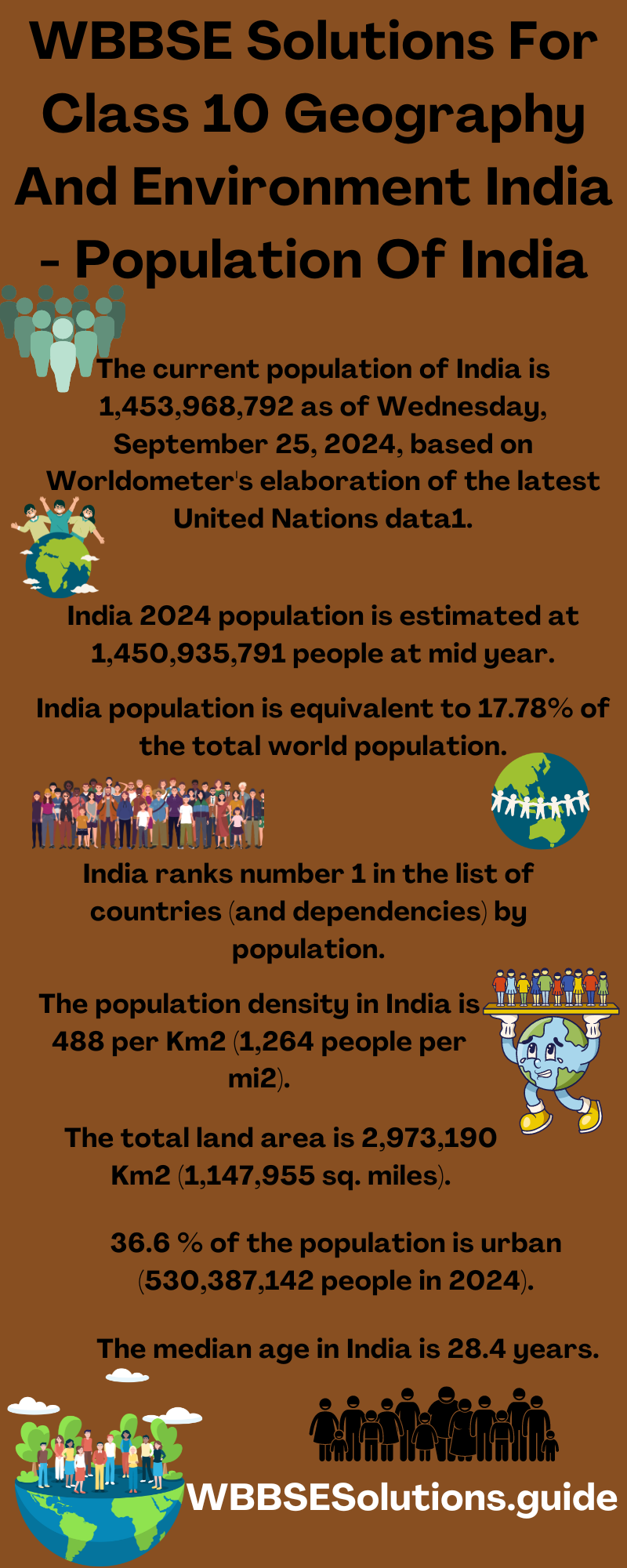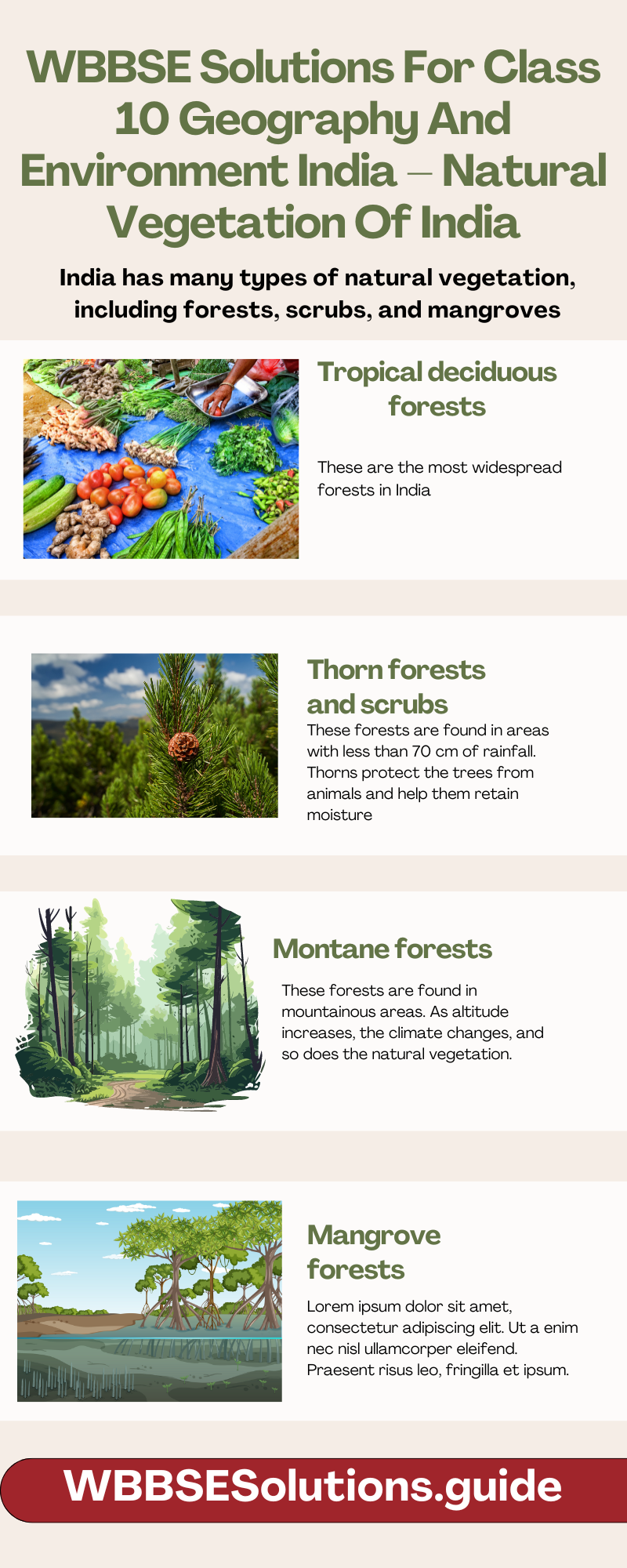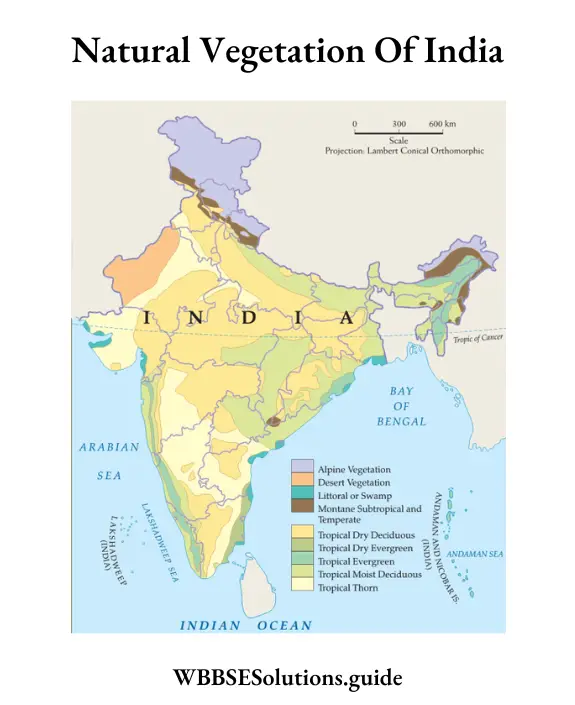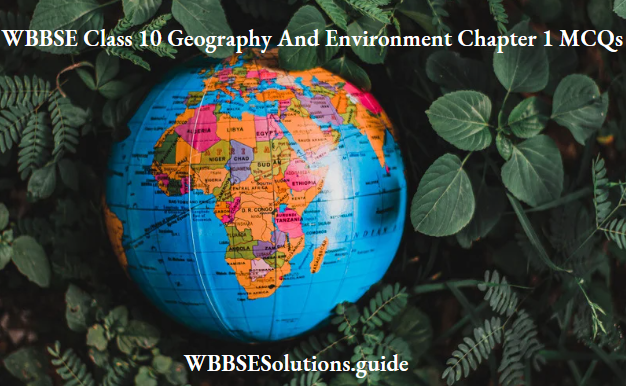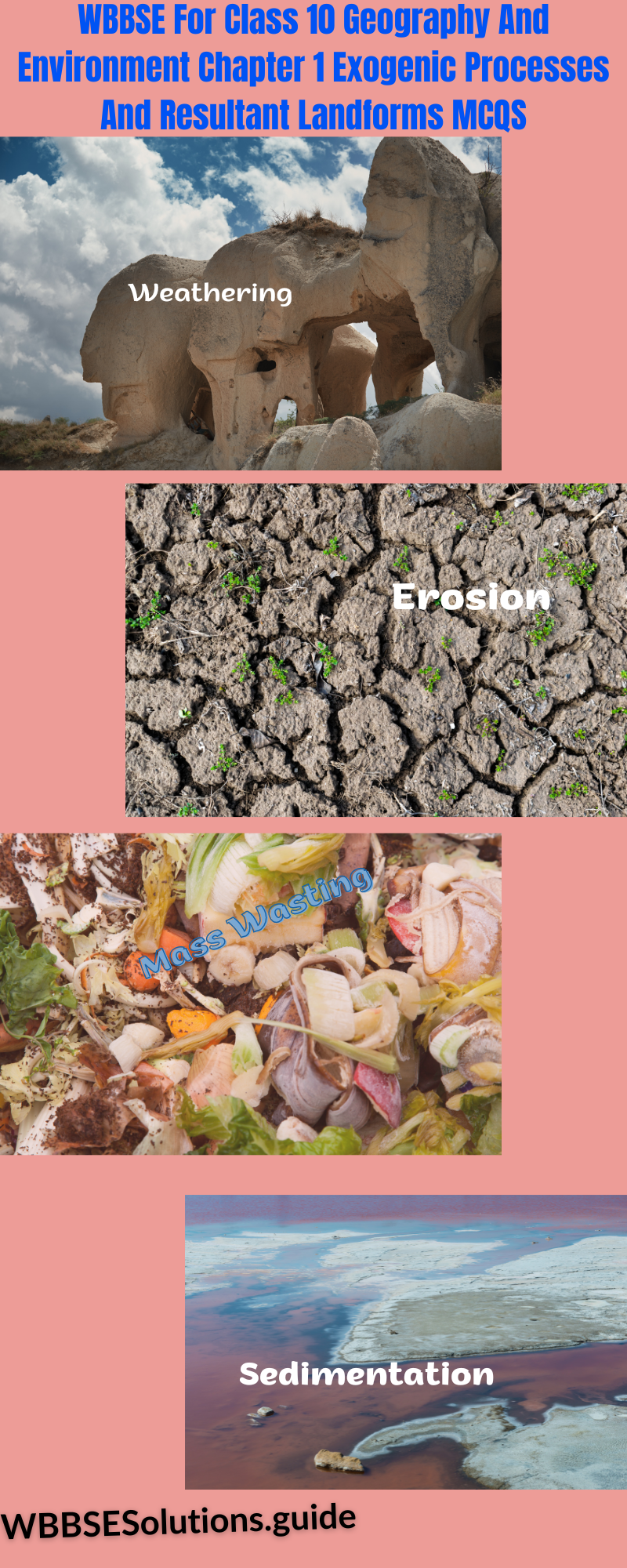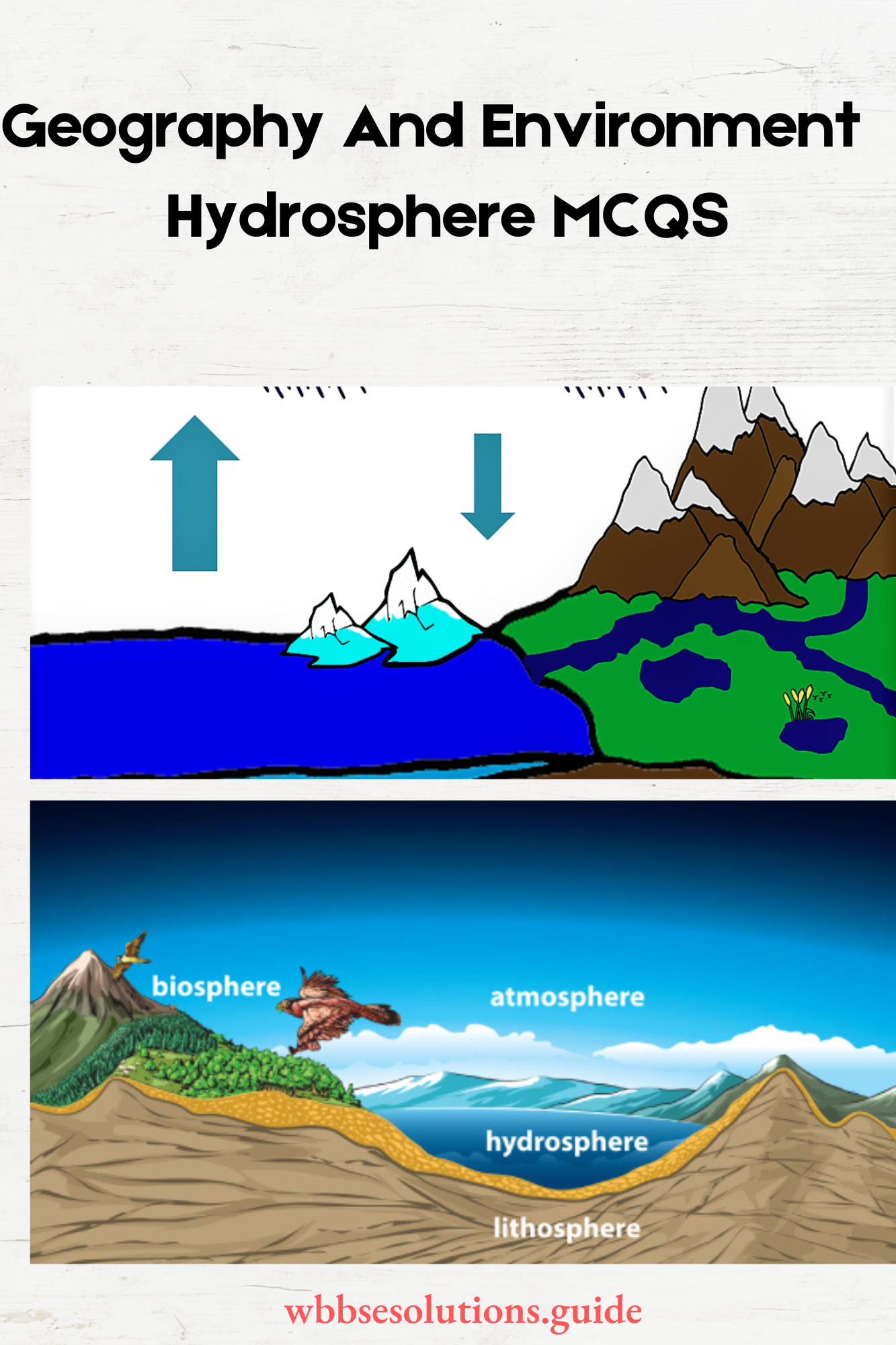Geography Class 10 West Bengal Board India – Physiography Of India True Or False Type:
Question 1. Aravalli in India is an example of a young fold mountain.
Answer: False
Question 2. The highest plateau of India is the Deccan Trap.
Answer: False
Question 3. In India, the Himalayas extend from the Nanga Parbat in the west to the Namcha Barwa in the east.
Answer: True
Read and learn all WBBSE Solutions For Class 10 Geography And Environment
Question 4. The central Himalayas extend into north-eastern India.
Answer: False
Question 5. Dodabetta is the highest peak of south India or the Deccan plateau.
Answer: False
“WBBSE Solutions for Class 10 Geography Physiography of India”
Question 6. The western coastal plain lies along the Bay of Bengal.
Answer: False
WBBSE Class 10 Geography Solutions
Question 7. The Punjab plain is drained by the Ganga and her tributaries.
Answer: False
Question 8. The Narmada Valley lies between the Vindhyas and the Satpura.
Answer: True
Question 9. The valley of Kashmir lies between the Pirpanjal and the Himalayas.
Answer: True
Question 10. Zoji-la Pass is located in Jammu and Kashmir.
Answer: True
Question 11. Nathu La is a pass in the Eastern Himalayas.
Answer: True
Question 12. Mt. Nandadevi is in the Western Himalayas.
Answer: True
Question 13. Mt. Saramati is the highest peak of Naga Range.
Answer: True
Question 14. Mt. Saddle Peak is in the Andaman & Nicobar Islands.
Answer: False
Question 15. Mt. Dhupgarh is the highest peak of Nilgiris.
Answer: False
Question 16. Mt. Anaimudi is the highest peak of South India.
Answer: True
Question 17. Mt. Amarkantak is the highest peak of Vindhya.
Answer: False
Question 18. The highest peak of the Western Ghats is Mt. Kalsubai.
Answer: True
Question 19. Deccan plateau is a Lava Plateau.
Answer: True
Question 20. Ladakh is the highest plateau.
Answer: True
Question 21. Marusthali is, in fact, a sea of sand with rock waste.
Answer: True
Question 22. The oldest mountain of India is the Aravalli.
Answer: True
Question 23. The highest plateau of India is the Pamir Plateau.
Answer: False
Question 24. The southernmost limit of India is Indira Point.
Answer: True
Question 25. The highest peak of the Nilgiri hills is Mt. Dodabetta.
Answer: True
Question 26. The desert of India is mainly situated in the state of Gujarat.
Answer: False
Question 27. Satpura is a block mountain of India.
Answer: True
Question 28. The western coastal plain receives heavy rainfall.
Answer: True
Question 29. Minicoy island is situated in the Manas Sarovar.
Answer: False
Question 30. The highest peak of India is Mt. Everest.
Answer: False
Question 31. Rajmahal hill is the highest part of the Ranchi Plateau.
Answer: False
Question 32. Satpura is a Block Mountain of India.
Answer: True
Question 33. The highest peak of Eastern Ghat is Mahendragiri.
Answer: True
“Class 10 Geography and Environment Physiography of India solutions WBBSE”
Question 34. Satpura consists of seven parallel ranges.
Answer: True
Question 35. Himalaya means abode of snow.
Answer: True
Question 36. Zoila is a pass of the Greater Himalayas.
Answer: True
Question 37. K2 is the highest peak of the Karakoram Range.
Answer: True
Question 38. Baltimore is a Glacier of the Karakoram.
Answer: True
Question 39. Khadars are the newer alluvial soil.
Answer: True
Question 40. Anairnudi is the highest peak of Nilgiri.
Answer: False
Question 41. Satpura is higher than the Vindhyas.
Answer: False
Question 42. Deccan trap is a intermontane plateau.
Answer: False
Question 43. Himalaya is an example of the oldest fold mountain.
Answer: False
Question 44. North-eastern hills of India are together known as Purbachal.
Answer: True
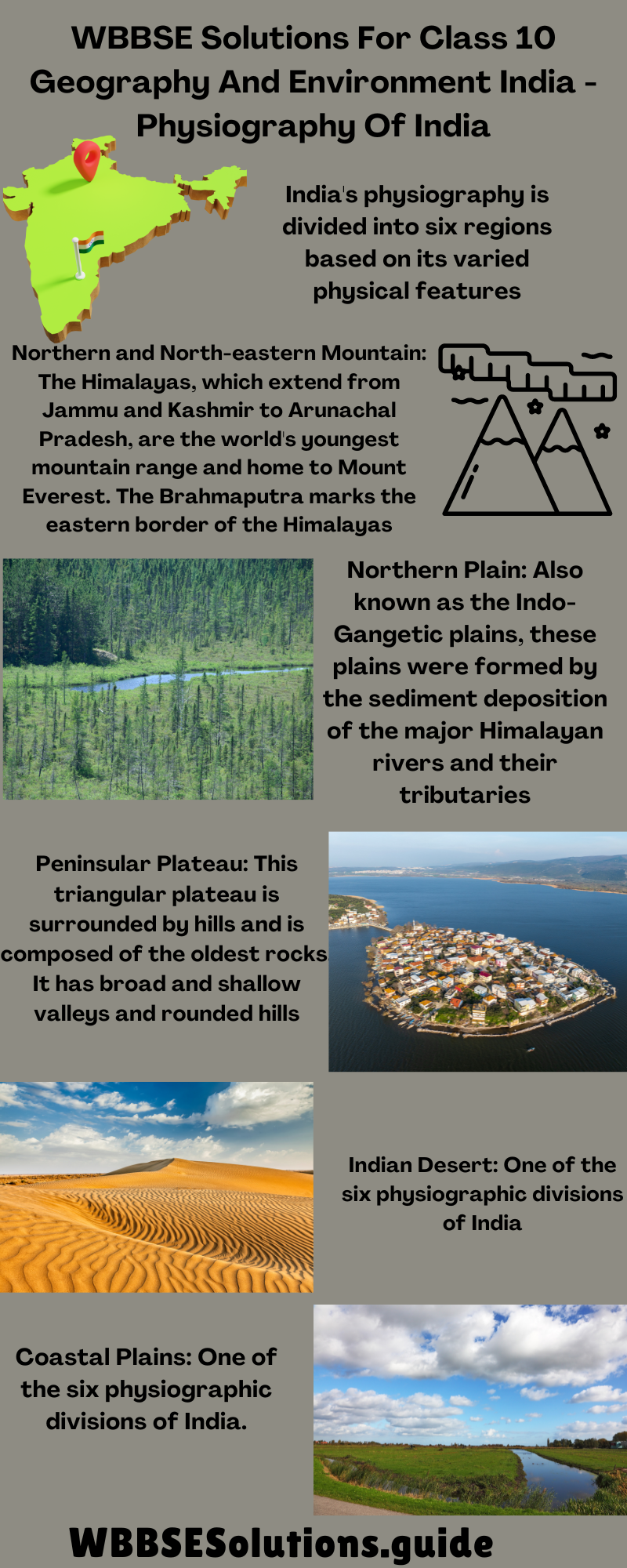
Class 10 Geography West Bengal Board India – Physiography Of India Fill In The Blanks Type:
Question 1. The highest mountain peak of South India is ______.
Answer: Anaimudi.
Question 2. The southernmost point of mainland India is ______.
Answer: Kanyakumari.
Question 3. ______ is the highest part of the Meghalaya Plateau.
Answer: Shillong.
Question 4. Mt.Trisul is in the ______ Himalaya.
Answer: Greater.
WBBSE Class 10 Geography Solutions
Question 5. ______ is a Glacier of the Karakoram Range.
Answer: Hesper.
Question 6. ______ is in between Himachal Pradesh and Tibet.
Answer: Sipki La.
Question 7. ______ Pass is in between Srinagar and Jammu.
Answer: Banihal.
Question 8. Jawahar Tunnel is an all-weather ______ to Srinagar Valley.
Answer: Tunnel.
Question 9. One mountain pass of J & K is ______.
Answer: Banihal.
Question 10. ______ plateau is part of the ancient Gondwanaland.
Answer: Deccan.
Question 11. The Eastern Coastal Plain of India lies along the coast of the ______.
Answer: Bay of Bengal.
Question 12. The Lakshadweep Islands lie in the ______sea.
Answer: Arabian.
Question 13. _______ is the highest peak in the Deccan.
Answer: Anaimudi.
Question 14. The northern plain of India was formed after the rise of the _______.
Answer: Himalayas.
Question 15. ______ was the sea from which the Himalayas rose up.
Answer: Tethys.
Question 16. ______ hills stand on the plateau of Meghalaya.
Answer: Garo.
Question 17. Indian desert lies in the west of the ______ range.
Answer: Aravalli.
“WBBSE Class 10 Geography Physiography of India solved questions”
Question 18. ______ is the highest peak of the Himalayas in India.
Answer: Kanchenjungha.
Question 19. Eastern Ghats is also known as ______.
Answer: Malayadri.
Question 20. _______ is the highest peak of the western ghats.
Answer: Kalsubai.
Question 21. Luni is the only ______ drainage of western India.
Answer: Inland.
WBBSE Class 10 Geography Solutions
Question 22. Himalaya means abode of ______.
Answer: Snow.
India – Physiography Of India Very Short Answer Type:
Question 1. What is ‘TaS’ in Western Himalaya?
Answer: Lakes / Glacial Lake / Water body
Question 2. Name the largest salt lake of the Thar desert.
Answer: Sambar Lake is the largest salt lake in the Thar desert.
Question 3. What is Himadri?
Answer: Himadri is the highest mountain range of the Himalayas in the North. It has snow-topped mountain peaks.
Question 4. What is Rohi?
Answer: The patches of more fertile tracks in the Northern and Central parts of Rajasthan are locally called Rohi.
Question 5. Name the islands on the Bay of Bengal.
Answer: The Andaman and Nicobar Islands are on the Bay of Bengal.
Question 6. Name the group of islands on the Arabian Sea.
Answer: The Lakshadweep is on the Arabian Sea.
Question 7. Name a lake in Manipur Valley.
Answer: Logtak is a lake of Manipur Valley.
Question 8. Which one is the highest plateau in India?
Answer: The Ladakh plateau of Jammu and Kashmir is the highest plateau of India.
Question 9. Name the highest peak in India.
Answer: Mt. Kanchanjunga (8595 m).
Question 10. Name the longest river in India.
Answer: Ganga.
Question 11. Name the longest tunnel in India.
Answer: Jawahar Lai Nehru Tunnel.
Question 12. Name the highest peak of Satpura.
Answer: Mt. Dhupgarh.
Question 13. Name the highest peak of Nilgiri.
Answer: Mt. Dodabetta (2637m).
Question 14. Name the highest peak of Annamalai.
Answer: Mt. Anaimudi.
Question 15. Name the highest peak of the Western Ghats.
Answer: Mt. Kalsubai.
Question 16. Name the all-weather tunnel to Srinagar Valley.
Answer: Jawaharlal Tunnel.
Question 17. Name one mountain pass in Himachal Pradesh.
Answer: Sipki La.
Question 18. Name the highest peak of Aravali.
Answer: Mt. Gurusikha.
Question 19. Name the highest peak of South India.
Answer: Mt. Anaimudi.
Question 20. By what name the Lagoons in the Kerala Coast are called?
Answer: Kayal.
Question 21. What is the local name of the dunes in the Malabar Coast?
Answer: Teris.
Question 22. Name the highest peak of the Karakoram Range.
Answer: Mt. Godwin Austin.
Question 23. Name the desert of India.
Answer: Thar Desert.
Question 24. What is the meaning of the name Satpura?
Answer: Satpura means seven parallel ranges of mountains.
Question 25. What is the meaning of the word Himalayas?
Answer: Abode of snow.
Question 26. Where is Zozila Pass located?
Answer: The Zozila pass is in Ladakh.
Question 27. Where do you find the Baltora Glacier?
Answer: Baltora Glacier is in the Karakoram Range.
Question 28. What are Belts?
Answer: Belts are narrow strips of low-lying floodplains.
Question 29. What are Khadars?
Answer: The newer alluvial plains of the Ganga Plain are called Khadars.
“Physiography of India Class 10 WBBSE solutions and answers”
Question 30. Where are Northern Circars?
Answer: The eastern coastal plain extending from the mouth of Subarnarekha to the mouth of Krishna is known as Northern Circars.
Question 31. What are Ghats?
Answer: The Ranchi Plateau is deeply dissected around its edges giving rise to escarpments locally called Ghats.
Question 32. Name the highest peak of Gir Mountain.
Answer: Mt. Gorakhnath.
Question 33. What is the other name of the Eastern Ghats?
Answer: Malayadri Mountain.
Question 34. What are Duns?
Answer: Duns are the flat-floored structural valleys mainly found in the Himalayas, e.g. Dehra Dun.
Question 35. Name the glaciers of the Karakoram Range.
Answer: Baltora, Bistro, Hisper, and Siachen.
Question 36. How many divisions are there in the Himalayas (West to East)?
Answer: West to East, the Himalayas have three divisions, these are Western Himalaya, Central Himalaya, and Eastern Himalaya.
Question 37. How many divisions are there in the (North to South) Himalayas?
Answer: Four divisions-Tethys or Trans Himalaya, Greater Himalaya, Lesser Himalaya, and Outer Himalaya.
Question 38. How many divisions are there in the Eastern Himalayas?
Answer: Four divisions-Sikkim Himalaya, Darjeeling Himalaya, Bhutan Himalaya and Arunachal Himalaya.
Question 39. Name three important passes of the Himalayas.
Answer: Burzilla, Zojila and Karakoram Pass.
Geography Class 10 Solutions WBBSE
Question 40. Name the knot from which the Himalayas is originating.
Answer: Pamir knot.
Question 41. Which is the oldest mountain in India?
Answer: Aravalli Range.
Question 42. Name five peaks of the Greater Himalayas.
Answer: Nanga Parbat (8125 m.), Kamet (7756 m.), Nandadevi (7817 m.), Dhaulagiri (8172 m), Makalu (8481m).
Question 43. Name two mountain passes in Jammu and Kashmir.
Answer: Mt. Everest, Mt. Annapurna, Mt. Makalu, and Mt. Gouri Sankar.
Question 44. What is the name of the extension of the Himalayas in the eastern region?
Answer: Purbachal.
Question 45. Name the highest peak of the Nanga Range.
Answer: Mt. Saramati (3823 m).
Question 46. Name the hills and ranges of the Purbachal.
Answer: Mikir, Barail, Lushai, Patkoi, Naga Hills, etc.
Question 47. Name the hills of the Meghalaya Plateau.
Answer: Garo, Khasi, and Jaintia.
Question 48. Name the highest peak of Rajmahal Hill.
Answer: Mt. Pareshnath (1366 m).
Question 49. Name the highest peak of Annamalai Hill.
Answer: Mt. Annamalai (2695 m).
Question 50. Name the highest peak of the Eastern Ghats.
Answer: Mt. Mahendragiri (1500 m).
Question 51. Name the highest peak of Andaman and Nicobar Islands.
Answer: Saddle Peak. (750 m).
Question 52. How many islands are there in Andaman Island?
Answer: 200 islands.
Question 53. How many islands are there in the Nicobar Island?
Answer: 10 islands.
Question 54. Name one active volcano in India.
Answer: Barren Island.
Question 55. Name one coral island in India.
Answer: Lakshadweep.
Question 56. Name the longest glacier in India.
Answer: Siachen glacier on the Karakoram range.
Question 57. What do you mean by ‘Purvanehal’?
Answer: The Northeastern hills are also known as Purvanehal.
Question 58. Which lake has the only floating park in the world?
Answer: The Loktak lake lies between the Naga and Lushai Ranges.
Question 59. Name the highest peak of the Western Himalayan range.
Answer: Dapha Bum.
Question 60. What is the meaning of the word ‘Meghalaya’?
Answer: Abode of clouds.
Question 61. Name the highest peak of Meghalaya.
Answer: Mt. Shillong Peak.
Question 62. What is the group of Coral islands in India called?
Answer: Lakshadweep.
Question 63. Name the highest peak of the Vindhya Range.
Answer: Manipur.
Question 64. Amarkantak is the highest peak of which range?
Answer: Maikal Range.
Question 65. Name the highest peak of Nilgiris.
Answer: Dodabetta.
Question 66. Where is Nanga Parbat located?
Answer: Jammu & Kashmir.
Question 67. Where is Namcha Barwa located?
Answer: Arunachal Pradesh.
Question 68. Name the southernmost range of the Himalayas.
Answer: The Shiwalik Range.
Question 69. Name the mountain range located in the north of the Great Himalayas and having the highest peak in India.
Answer: Karakoram Range.
Question 70. Name the mountain range in the south of the Narmada River and parallel to it.
Answer: The Satpura Range.
Question 71. Name the mountain range in the north of the Narmada River and running parallel to it.
Answer: The Vindhya Range.
Question 72. Name the mountain range flanking the northeastern edge of the Malwa Plateau.
Answer: The Aravalli Range.
Question 73. Name the longest hill range of south India.
Answer: Western Ghats or Sahyadri.
Question 74. Name the Himalayan pass located in Himachal Pradesh and touching the Indo-China border.
Answer: Shipki La.
Question 75. Name the mountain pass in Jammu and Kashmir located at the Indo-China border.
Answer: Karakoram Pass.
Question 76. The one mountain pass in Arunachal Pradesh.
Answer: Bondi La.
Question 77. Name the gap in the Western Ghats which is used by rail link between Mumbai and Chennai.
Answer: BhorGhat.
Question 78. Name the southernmost gap in the Western Ghats.
Answer: Pal Ghat.
Question 79. Name any one pass located in Sikkim.
Answer: Nathu La or Jelep La.
Question 80. What do you mean by Indira Col?
Answer: Indira Col is the northernmost point of India at 37°6-north latitude. It is located at the strategic point at the northern border of Jammu and Kashmir where the boundaries of four countries — India, Pakistan, Afghanistan, and China meet.
Question 81. Name a plateau located in the north of the Vindhya Range.
Answer: Malwa Plateau.
Question 82. Name the plateau in the northeastern part of the Indian peninsula which is rich in mineral resources and through which the Damodar River flows.
Answer: Chotanagpur Plateau.
Question 83. Name the plateau continuous to the Himalayan ranges but belonging Peninsular plateau.
Answer: Meghalaya Plateau.
Question 84. Name the plateau formed by volcanic eruptions and rich in black cotton
Answer: Deccan Plateau.
Question 85. Name the plateau drained by the river Mahanadi and its tributaries.
Answer: Chhattisgarh.
Question 86. Name the coastal plain between Mumbai and Goa.
Answer: Konkan plain.
Question 87. Name the coastal plain between the Krishna and Cauvery rivers.
Answer: Coromandel.
“WBBSE Class 10 Geography Physiography of India chapter answers”
Question 88. Name the coastal plain of Kerala.
Answer: Malabar.
Question 89. Name the gulf on the coast of which Kandla port is located.
Answer: Gulf of Kuchchh.
Question 90. Which strait separates India from Sri Lanka?
Answer: Palk Strait.
India – Physiography Of India 2 Marks Questions And Answers:
Question 1. Where is Malnad region located?
Answer:
Malnad, literally meaning hilly country, is the portion bordering the Sahyadri having an average width of 3 km and a mean elevation of 1,000 m. it is dissected into steep hills and deep valleys. The northern and south-eastern portion of the Mysore (or Karnataka) plateau, an area of rolling plains and granite hills, is called Malnad.
Question 2. What is Dhrian? Where is it found?
Answer:
Dhrian:
Longitudinal dunes are known as Dhrian. It is found in the Thar desert.
Question 3. Name the oldest mountain range of India and the state where it is located.
Answer: The Aravalli is the oldest mountain range in India. It is located in Rajasthan.
Question 4. Which is the highest peak of the Himalayas situated in India? Where is it located?
Answer: Kanchenjunga (8,598 m) is the highest mountain peak in India located in the Himalayan Range in Sikkim.
Question 5. What is Purbachal?
Answer:
Purbachal:
The branches of the Himalayas in the northeastern region are together known as Purbachal. The whole northeast hilly region is included in this region.
Question 6. Where is the Eastern Ghat located? Name its highest peak.
Answer: Eastern Ghat is located on the Eastern coast. Mahendragiri is its highest peak.
Question 7. Name one mountain pass in the Western Himalayas and one mountain pass in the Eastern Himalayas.
Answer: The Burzil Pass (4,199 m) lies over the Great Himalayas of Western Himalayas. The communication is between Srinagar and Gilgit. Nathula La in Sikkim of Eastern Himalayas. The communication is between Sikkim and Tibet.
Question 8. What is the significance of the name Himalayas?
Answer: Hima means snow and Alaya means home. The vast snow fields attracted the attention of ancient Indian sages who rightly named it Himalaya.
Question 9. Name three hills of the Meghalaya plateau.
Answer:
The three hills of the Meghalayan plateau are:
1. Garo,
2. Khasi and
3. Jayantia hills.
Question 10. Compare and contrast the East Coast with the West Coast of India.
Answer:

Question 11. Why is the Himalayan mountainous region prone to earthquakes?
Answer: Himalayas is extended from East to West in the north of India. It is a young fold mountain. The land is not yet balanced here. The geologists believe that the procedure of the formation of mountains is still not terminated. Hence, the balance of the earth is going on slowly. So, the Himalayan mountainous region is prone to earthquakes.
Question 12. Where are the Siwalik ranges located?
Answer: Siwalik Range is the southernmost range of the Himalayas. This range extends from the Potwar Plateau in the West to the Brahmaputra valley in the East.
“Class 10 Geography Physiography of India WBBSE notes”
Question 13. Mention the extent of the Himalayas in India.
Answer: The Himalaya is extended from Nanga Parbat in Kashmir in the West to Namcha Barwa near Arunachal Pradesh in the East.
Question 14. State the origin of the Himalayas according to plate tectonic theory.
Answer: According to the theory of ‘Plate Tectonic’, the crust of the earth comprises six plates. All plates are moving. The two plates, the ‘Indian peninsular plate’ and ‘Siberian plate’ collided with each other. As a result, the fringe of the Indian Peninsular Plate folded forming the Himalayan Mountains.
Question 15. Name three mountain ranges of the Deccan plateau.
Answer:
The Deccan plateau comprises of three important mountain ranges:
1. Satpura- Mahadev mountain range,
2. Ajanta and
3. Western Ghats.
Question 16. Where is the ‘Nanga Parbat’ located?
Answer:
‘Nanga Parbat’ is situated in North Kashmir on the Great Himalaya range. In the western region where the Indus bends and enters Pakistan, stands the Nanga Parbat (8,126 m.)
Question 17. Floods are frequent in the Brahmaputra Valley. Why?
Answer:
Floods are frequent in the Brahmaputra Valley
Brahmaputra Valley is situated between the Himalayas and the Meghalaya Plateau. The region receives heavy rainfall throughout the year, so heavy rainfall causes floods. The river Brahmaputra along with its tributary deposits plenty of silt in the river bed thereby making it shallow and causing floods. The river Brahmaputra has taken a zigzag course causing a flood. The region is prone to earthquakes and floods.
Question 18. Name the highest peak and the longest river of the Deccan.
Answer: The highest peak of the Deccan is Mt. Anaimudi. The longest river of the Deccan is Godavari.
Question 19. Name the highest peak of Nilgiri and name the highest peak of the Satpura Range.
Answer: The highest peak of Nilgiri is Mt. Dodabeta. The highest peak of Satpura is Mt. Dhupgarh.
Question 20. Name two famous valleys of Himachal Pradesh.
Answer: Kulu and Kangra Valleys.
Question 21. Divide Gujarat Plains.
Answer:
Gujarat plains are divided into two parts:
1. Kuchchh peninsula and
2. Kathiawar peninsula.
Question 22. Name three mountain passes of the Himalayas.
Answer:
The three mountain passes of the Himalayas are:
1. Banihal pass,
2. Zoji La pass and
3. Shipki La pass.
Question 23. Name the mountain gaps or passes of the Western Ghats mentioning their location.
Answer:
The important gaps or passes in the Western Ghats are:
1. The Thai Ghat,
2. The Bhor Ghat in the eastern part of Mumbai and
3. Pal Ghat in the South of the Nilgiri hills.
Question 24. Name the glaciers of the Himalayan range.
Answer: Mountain peaks are covered by perpetual snow. Himalaya is the home of many glaciers such as Gangotri and Yamunotri on the Himalayas, Siachen, Great Baltora and Hesper on the Karakoram range.
Question 25. Name some of the beautiful valleys of the Himalayas.
Answer: The important valleys of the Himalayas are the valley of Kashmir, the Valley of Kulu and Manali, Dehradun, Kangra Valley, and so on.
Question 26. What do you mean by “Dun”?
Answer:
Dun: Broad longitudinal valleys lying between the main Himalayas and the Shiwalik range formed by the deposition of materials brought down by Himalayan rivers, are called ‘duns’.
Example: Dehradun
“WBBSE Solutions for Geography Class 10 Physiography of India MCQs and answers”
Question 27. Mention the divisions of the Himalayas.
Answer:
Divisions of the Himalayas:
From West to East: The Himalayas can be broadly divided into three divisions:
1. The Western Himalayas,
2. The Central Himalayas,
3. The Eastern Himalayas.
From North to South: The Himalayas can be divided into four divisions:
1. The Trans or Tethys Himalayas,
2. The Greater Himalayas,
3. The Lesser Himalayas,
4. The Outer Himalayas or Siwalik Rang
WBBSE Class 10 Geography Chapter 5 Question Answer India – Physiography Of India 3 Marks Questions And Answers:
Question 1. The Himalayan region is sparsely populated. Why?
Answer:
The Himalayan region is sparsely populated because of the following reasons:
1. Rugged surface,
2. Harsh climate,
3. Lack of .fertile agricultural plain land,
4. Lack of transport and communication. Railways are absent here,
5. Absent of large-scale industry,
6. Lack of raw materials: though the region is rich in minerals, because of the rugged surface and lack of roadways, it is very difficult to explore them.
7. Earning of living is not easy here,
8. Lack of wide market.
Question 2. Kashmiris called ‘Heaven of the Earth’-Why? Or, Tourism has been developed in Kashmir- Explain why.
Answer:
Kashmiris called ‘Heaven of the Earth’
Kashmir lies in the mountain bed of the western Himalayas. The natural scenes are very attractive here. The peaks covered by sheets or blankets of snow, swift-flowing rivers, beautiful waterfalls, colourful flowers here and there, the sound of birds, and many more scenes make Kashmir like heaven. Hence, due to these attractive natural scenes, it is called “Heaven of the Earth”. Due to these factors, people come here from distant places to view and enjoy the natural beauty of Kashmir. Hence, it is a tourist abode place and many hotels are formed here.
Question 3. The Himalayan mountain chain is prone to earthquakes Why?
Answer:
The Himalayan mountain chain is prone to earthquakes
Himalayan mountains are newly formed fold mountains. Here the mountain-building activity has not yet been done completely. There are certain movements in the surface to stable the unstable equilibrium. Hence these movements are responsible for the origin and the occurrence of earthquakes. That is why the Himalayan mountain chain is prone to earthquakes.
Question 4. Heavy industries are not developed in the Himalayan mountainous region. Why?
Answer:
The region of the Himalayas mountains has a scarcity of heavy industries due to the:
1. Absence of transport system The Himalayan region is mountainous and hard. So there is the absence of a Railway system. The rivers of this region are very swift flowing so they are not navigable. Hence, the transport system of this region is not developed leading to a scarcity of heavy industries.
2. Lack of raw materials As the surface is not fertile, there is no development or growth of agriculture. Due to lack of facilities, minerals are not mined. Hence agro-based or mineral-based industries are not developed due to a lack of necessary raw materials.
3. Lack of cheap labour due to lack of survival conditions here the population is low. Hence cheap and skilled labour is not available.
4. Absence of power stations Lack of coal and hydel power stations is another cause for an industry to develop in the Himalayan regions.
Question 5. Write in short about the Brahmaputra Valley.
Answer:
Bramhaputra Valley: The Brahmaputra valley has been built up by the aggradational work of the Brahmaputra valley and the lower Brahmaputra valley. A large number of isolated hillocks of monadnocks on both banks of the river right from Tezpur and Mikir Hills to as far West as Dhubri is another interesting feature of this valley.
Another significant physical characteristic of Brahmaputra valley is that the river itself is highly braided because of its very low gradient. There are a large number of river islands in it. Majuli is the largest river island in the world covering 929 sq. km. Brahmaputra valley is covering an area of 56,500 sq. km of the state of Assam. Floods are very frequent here because of the shallow river beds and heavy rainfall in this region. A huge deposition of silt has made the river bed shallower.
Question 6. Name the divisions of the Ganga plain.
Answer:
Divisions of the Ganga plain

Question 7. What is Deccan Trap?
Answer:
Deccan Trap
A vast area extending from the Arabian sea coast in the West as for as Nagpur and Gujarat in the North to Belgaon in the South is covered with a thick mantle of plateau mainly made of Basalt, called the Deccan Trap. It is a lava plateau. The mechanical weathering has given rise to flat-topped hills flanked by terraces or steps. The word trap is used to describe its structure because the trap is a Swedish word meaning steps or stairs.
“Physiography of India WBBSE Class 10 question answers PDF”
Question 8. Name the three mountain passes of the Himalayas.
Answer:
Mountain passes are the narrow gaps in mountain ranges. The three important mountain passes of the Himalayas are
(1) Banihal pass,
(2) Zojila pass and
(3) Shipki La pass.
Class 10 Geography West Bengal Board
Question 9. Name the glaciers of the Himalayan range.
Answer:
Glaciers of the Himalayan range
The mountain peaks are covered by perpetual snow. Himalaya is the home of many glaciers; such as Gangotri and Yamunotri on the Himalayas, Siachen, Baltoro and Hisper on the Karakoram range.
Question 10. Name some of the beautiful valleys of the Himalayas.
Answer:
The important valleys of the Himalayas are the valley of Kashmir, the valleys of Kulu and Manali, Dehradun, Kangra valley and so on.
Question 11. Name three mountain gaps or passes of the Western Ghats mentioning their location.
Answer:
The important gaps or passes in the Western Ghats are:
(1) The Thai Ghat and
(2) The Bhor Ghat in the eastern part of Mumbai, and
(3) The Pal Ghat in the south of the Nilgiri Hills.
Question 12. Describe the relief of the Kashmir Himalayas and Himachal.
Answer:
T he relief of the Kashmir Himalayas and Himachal
1. The Kashmir Himalayas is located in the state of Jammu and Kashmir. The mountains of the region from South to North are Jammu and Punch hills of the Zaskar Range constitute the Great Himalayas. To the North of the Himalayas, there is the deep gorge created by the river Indus. To the extreme North of Jammu and Kashmir lies the Karakoram mountain with its highest peak Godwin-Austin or K.
2. The Himachal Himalaya includes the Siwalik mountain in the South, to its North lie the Middle Himalaya which include the Dhaoladhar, Pirpanjal, Nagtibba and Missouri ranges. Further North lies the Great Himalayas.
Question 13. Name the physiographic divisions of India.
Answer:
India can be divided into the following physiographic divisions
1. Northern mountain.
2. Plains of North India.
3. The Peninsular Plateau.
4. Coastal Region.
5. Islands.
Question 14. Name the three parallel ranges of the Himalayas and state some typical characteristics of each.
Answer:
The three parallel ranges of the Himalayas are
(1) Great Himalayas or the Himadri: The northernmost and loftiest range is called Himadri. Mount Everest is the highest peak in the world located in this range.
(2)Middle or lesser Himalayas other Himachal: All the important hill stations belong to this range such as Dalhousie, Dharmshala, Shimla, Mussoorie, Nainital and Darjeeling.
(3)Outer Himalayas or the Shiwalik Ranges: These ranges are made of unconsolidated river deposits and are prone to earthquakes and landslides.
Question 15. Where is the Assam Valley? Why is it so flood-prone?
Answer:
Assam Valley is flood-prone: The Assam valley extends from Saidya in the east to Dhubri in the west where the Brahmaputra turns southwards and takes the western edge of the Garo hills and Meghalaya. The Brahmaputra floods normally begin in May with the thawing of snow in Tibet and the Eastern Himalayas and they are aggravated by the heavy monsoon rains from June to September. The rise in the level of water in the Brahmaputra prevents the water of the tributary streams from entering it. The blockade to the rise of water- levels in tributary streams causes widespread floods. The region is in the earthquake zones. Because of the inside movements, sometimes the riverbed rises causing food. The river Brahmaputra has taken a zigzag course. Because of the increase of water the river breaks through the narrow margin between two bends and causes floods.
Question 16. Write the significance of the coastal plains of India.
Answer:
Significance of the Coastal Plains of India:
(1) The deltas of Mahanadi, Godavari, Krishna and Kaveri on the Eastern coastal plain have rich fertile soil. They produce crops like rice, sugarcane, spices, etc. and support our agricultural economy,
(2) The ports of Mumbai, Marmagao, Cochin, Chennai, and Vishakhapatnam help to promote our international trade,
(3) The flat coastal plains present ideal sites for settlements,
(4)Marine fishing is an important occupation of the people of coastal plains,
(5) The deltas of Krishna, Godavari, Kaveri, etc. have been explored for oil and natural gas extraction. They can thus become potential sources of mineral oil.
Question 17. Write the significance of the islands of India.
Answer:
The Islands:
(1) The islands of Andaman and Nicobar provide valuable timber like mahogany, ebony, teak, etc.
(2) Variety of spices are also produced on these islands which are mainly exported,
(3) The extraordinary beauty of these islands attracts tourists from far and wide. They thus help to develop the tourism industry also.
Question 18. Difference between Bhabar and Tarai:
Answer:
Difference between Bhabar and Tarai:
| Bhabar |
Trai |
| 1. It lies along the foot of the Shiwaliks from the Indus to the Tista. |
1. It lies to the south of the Bhabar and runs parallel to it |
| 2. It is 8 to 16 km wide. |
2. It is 20 to 30 km wide. |
| 3. It comprises pebble-studded rocks |
3. It is composed of comparatively finer alluvium and is covered by forests. |
| 4. Due to the porosity of the rocks, the streams disappear and flow underground. |
4. The underground streams of the bhabar re-emerge in the surface and give birth to marshy areas. |
| 5. This region is not much suitable for agriculture. |
5. Most parts of the terai area are reclaimed for agriculture. |
Question 19. Difference between Bhangar and Khadar:
Answer:
Difference between Bhangar and Khadar:
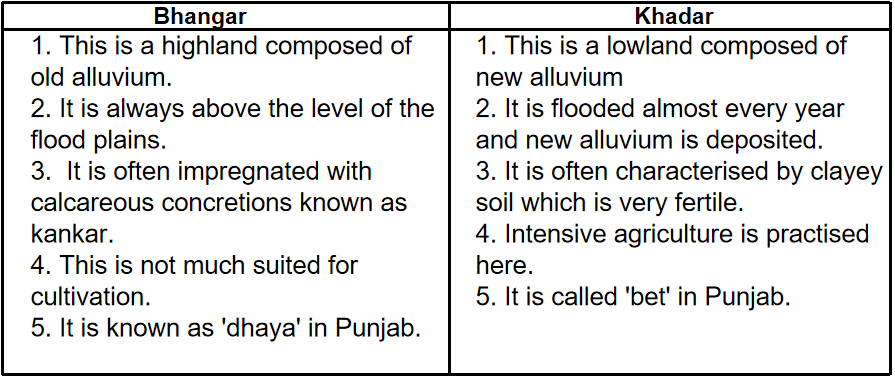
Question 20. Difference between Western Ghats and Eastern Ghats.
Answer:
Difference between Western Ghats and Eastern Ghats:
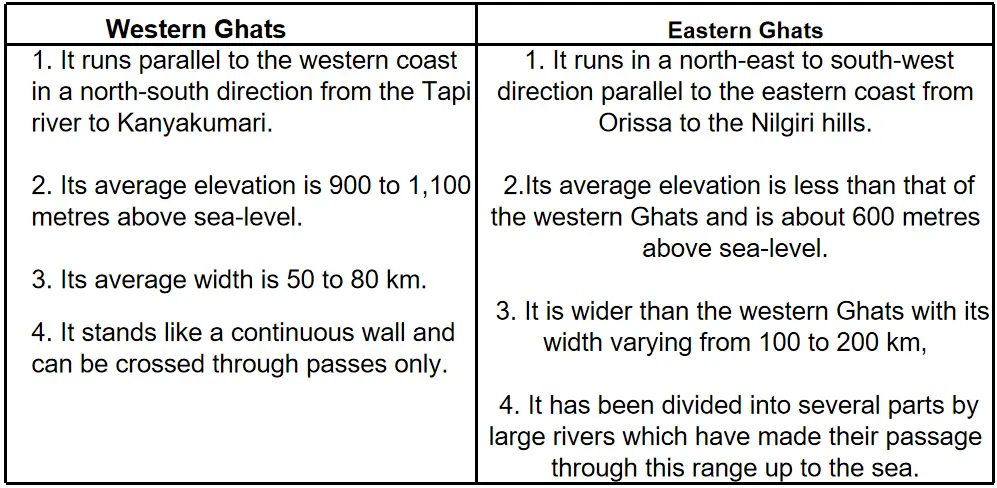
Question 21. Discuss the features of the Deccan plateau of India.
Answer:
The Deccan Plateau has the following features:
(1)The northern part of the Deccan Plateau has the Maharashtra Plateau composed of lava sheets and displays flat and steep hills, ridges and shallow, broad valleys.
(2)The Andhra (Telangana) Plateau has hilly and forest-covered northern parts and plain land with small hills and minor depressions in its southern portion.
(3)The Karnataka Plateau forming the middle parts of the Deccan Plateau rises to the southwest and joins the Nilgiri Hills. Its northern area, less than 600 m in height, has the Krishna river flowing through its east. The southern area of the Karnataka Plateau is higher with an average elevation of 600 to 900 m. It has the Cauvery river running through its southeast.
(4)The Deccan Plateau displays a sudden narrowing of land below the Karnataka Plateau. Here, it comprises uplands made by the hills of Palni, Nilgiri, Cardamom and Annamalai. It is bordered on its sides by the Tamil Nadu and Kerala plains.
India – Physiography Of India 5 Marks Questions And Answers:
Question 1. Give a brief account of the physiography of the Western Himalayas of India.
Answer:
Physiography of the Western Himalayas of India
Physiography of Western Himalaya: According to SirS. Burrard, the Himalayas are generally regarded as consisting of the following four main sections which are separated from one another by the gorges of rivers which pass through them:
(1)The Punjab HimalayasThis section between the Indus and the Sutlej is known as the Punjab Himalayas. It is also called Jammu-Kashmir and Himachal Pradesh Himalaya because most of this section is located in these two states. This section is 560 kilometres long. The important ranges of this section are the Ladakh, the Pir Panjal, the Dhaoladhar and the Zanskar. The Zoji La pass is at an altitude of 3,444 metres above the sea-level.
(2)The Kumaon Himalayas This section runs for a distance of 320 kilometres between the Satluj and the Kali rivers. This is higher than the Punjab Himalayas. Great rivers like Ganga and Yamuna have their sources in the Kumaon Himalayas.
(3)The Upper HimalayasThis is situated between the Kali and the Tista rivers and is 800 kilometres long. This is the highest part of the Himalayas where lofty peaks like the Mt. Everest, the Kanchenjungha, the Dhaulagiri, the Annapurna, the Makalu, etc. are located. The flat Kathmandu valley is also situated in the Nepal Himalayas.
(4)The Assam HimalayasIt extends for a distance of 720 kilometres between the Tista and the Dihang (Tsangpo-Brahmaputra).
Question 2. State the physiographic differences between the Eastern and Western Coastal Plains of India.
Answer:
Differences between the Eastern and Western Coastal Plains of India:
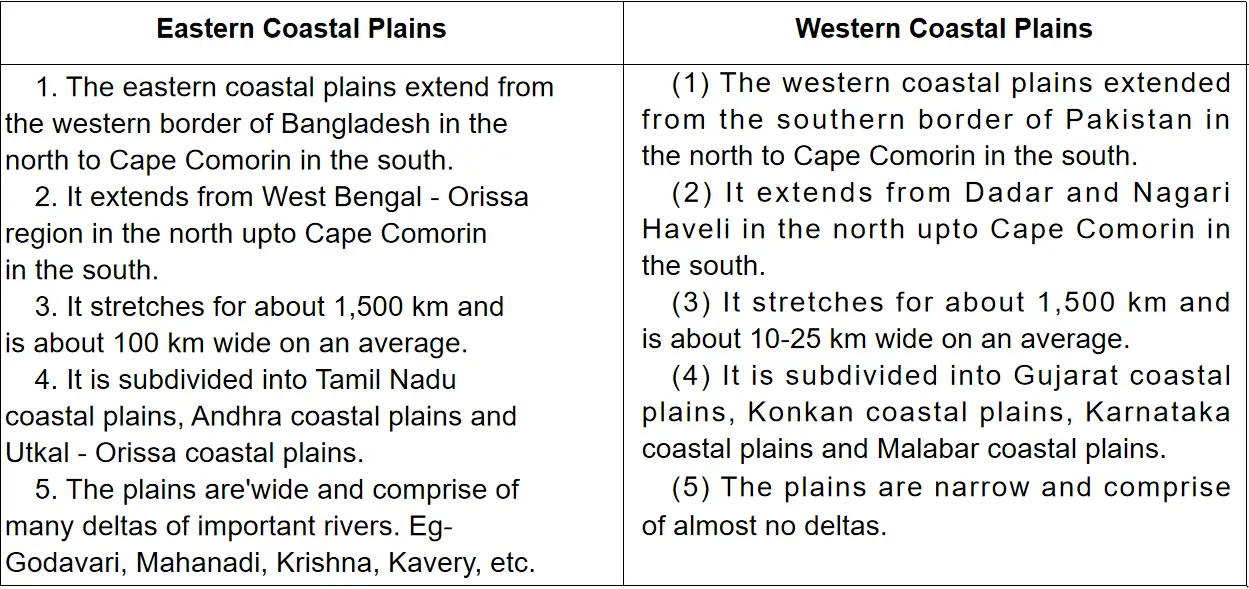
Question 3. Discuss the origin of the Himalayas.
Answer:
Origin of the Himalayas:
Birth of the Himalayas: The recent geological research and observations provide new insight into the mechanism of Plate Tectonic Theory which led to the formation of the Himalayas.
Plate Tectonic Theory: The observations show a major reorganisation of the plate around the Indian Ocean about 50 million years ago and this is interpreted as the effect of the collision between Indian and Eurasia plates. In this process continental crust, squeezed by the collision, was then shortened by about 2,600 km. Before the continental mass of India collided with continental mass of Eurasia, the thinner oceanic crust of the then Tethys Sea to the North of India slipped quietly underneath the Eurasian crust. The collision which took place roughly 50 million years ago is responsible for the upthrusting that has produced the Himalayas.
Continental Drift Theory: According to Alfred Wegner, hundreds of million years ago all the land surfaces were joined together to form a massive continent. This supercontinent was known as Pangea. Due to certain factors, this Pangea was broken and each piece moved away from the other and ultimately formed the continents. But as the fragments of land moved away from their mother form, soon all of them approached each other and that resulted in the formation of fold mountains.
Contraction Theory: Due to continuous heat radiated from the interior of the earth the contraction process caused the outer surface to be crumbled like a skin of a dried apple. These formed the fold mountains.
Geosyncline Theory: According to this theory, the Himalayas are coming out of a sea called Tethys. Because of tremendous pressure, the sedimentary rocks of this Tethys Sea got folded and uplifted and thus created the Himalayas.
Question 4. Classify and describe Himalayas from East to West. Or, Describe the regional divisions of Himalayas.
Answer:
Regional Division The Himalayas have been divided into three regional divisions, they are:
Western Himalayas They are again sub-divided into the following heads:
(1) Kashmir Himalayas It is located in the state of Jammu & Kashmir. It consists of Zanskar Range, Ladakh Range, etc. The Great Kashmir Valley lies in this region. The highest peak of India, K? (8,611m) & the highest plateau of India, Ladakh Plateau are
located here.
(2) Himachal Himalaya It is located from South: East of Jammu & Kashmir and enters in Himachal Pradesh. The Dhauladhar Range, the Pirpanjal Range, Nagtiba Range, Mussorie Range lie here.
(3) Kumaun Himalayas: The Himalayan stretch along the North of the U.P. are called Kumaun Himalayas. The region consists of mountain peaks like Nanda Devi (7,817m), Gangotri (6,614m), Kedarnath (6,990m), etc.
Central Himalayas: Central Himalayas are located in Nepal. Its highest peak is Mt. Everest which is the world’s highest peak.
Eastern Himalayas: This region can also be sub-divided into 3 regions
(1) Sikkim: Darjeeling Himalayas It is enclosed between Singalila & Dankhya Ranges. Kanchanjungha is situated in the Sikkim. On the southwestern corner of the region lie Darjeeling Himalayas.
(2) Bhutan Himalayas: The relief in this region is very rugged. The highest peak in this region is Chomolahari (7,314m).
(3) Assam or Arunachal Himalayas: This part of the Himalayas comprises several fertile valleys like Kamla valley. The Shiwalik Himalayas are very narrow here. Namcha Barwa is located in this region. The whole region is dissected by numerous rivers like Dibang, Kamla, Dihang and Subansiri.
Geography Class 10 Solutions WBBSE
Question 5. Compare and contrast the east coast with the west coast of India. Or, Draw a comparison between the eastern coastal plains and the western coastal plains.
Answer:
| East Coast |
|
West Coast |
|
1. Width |
|
| 1. It is wider, from 80-20 km. |
|
1. It is narrow, from 40-80 km. |
|
2. Topography |
|
| 2. Coastline is regular and compact. |
|
2. Coastline is broken in many places. |
|
3. Neighbouring Sea |
|
| 3. Coastal plains are washed by the Bay of Bengal. |
|
3. Coastal plains are washed by the Arabian sea |
|
4. Division |
|
| 4. It is divided into Coromandai coast, Northern Circar, Utkai coast, and Contai coast |
|
4. It is divided into the Konkan coast, Kathiawar coast, Kutchchh coast, Kanarese coast and Malabar coast |
|
5. Rivers and their movement |
|
| 5. The rivers are large and flow slowly. |
|
5. The rivers are small and they flow swiftly. |
|
6. Rainfall |
|
| 6. Receives less rainfall but twice in a year |
|
6. Receives very heavy rainfall but once a year. |
|
7. Fertility |
|
| 7. The soil is very fertile so agriculture is productive. |
|
7. The soil is less fertile so agriculture is not so productive |
|
8. Deltas |
|
| 8. The rivers have a delta on their mouth |
|
8. The rivers do not form a delta in their mouth. |
|
9. Development |
|
| 9. Moderate economic development. |
|
9. Much economic development |
|
10. Population |
|
| 10. Density of the population is very high |
|
10. Density of the population is low except southern region |
Question 6. State the importance of the Himalayas.
Answer:
The social, financial, cultural and political conditions of India are affected by the Himalayas. The importance of the Himalayas are:
(1)Natural Barrier Himalayas act as a natural barrier to protect India from foreign invasion or foreign attacks.
(2)Source of Rivers Himalayas are mainly covered by snow. Hence it originates many rivers which are useful for humans and animals, e.g. Ganga, Yamuna, etc.
(3)Effect on AgricultureAs a mountainous region it is not suitable for agriculture. But terraced farming is practised on slopes and rice, tea, wheat, fruits are grown here.
(4)Production of H.E.P.The rivers originating from the Himalayas are very suitable for hydroelectric power.
(5)Rich wealth of Natural Vegetation Himalayas have nice forest cover. From these forests, wood of high quality can be obtained.
(6)Mineral Resources Himalaya is also known as a ‘storehouse of minerals’. The rocky part of the Himalayas is rich in minerals.
(7)Climatic influence
1. It prevents the cold winds of Central Asia to entering India. Hence it saves the people of India from severe cold.
2. It stops the southwest monsoon winds to cause heavy rainfall in northern India.
(8)Tourist abode places Having high elevation Himalayas are tourist attractions. The Jammu and Kashmir region and the Darjeeling region are famous.
Question 7. Write about the importance of the Great plains in the life of the Indian people.
Answer:
The importance of the Great plains of India is the following
1. Fertile Land This plain is very fertile. Hence, the agriculture, and transport system is well-developed here.
2. AgricultureThe northern plain is an agricultural region (except the Rajasthan plains). Large amounts of rice, jute, sugarcane, wheat, cotton, pulses, oilseeds, etc. are produced. Hence this region is called the Granary of India.
3. Transport Facility It is a plain region, hence, roadways and railways are also navigable. Thus, while India is connected with this part.
4. Irrigational Facility: The surface is soft, so wells are made here. The perennial rivers are always ready to provide water for irrigation.
5. Dense population The population density is the highest in this region. India’s 45% population is inhabited here. Thus many large cities have grown in this plain, e.g. Delhi, Agra, Lucknow, Patna, Calcutta, Varanasi, etc.
6. Development of Industries There are many industries located here due to the advantages of communication, raw materials, cheap labour, etc. The major industries are Sugar Industry, Textile Industry, and Jute industry which is mainly agro-based industries.
7. Centre of Civilization and Culture From ancient times these plains are the centres of civilization and culture. Harappan civilization, Gangetic valley civilization, etc. are located here. Many pilgrimages are also located here.
Question 8. Describe the importance of the Deccan plateau region.
Answer:
The importance of the Deccan plateau region are
1. This plateau is an important source of iron ore, coal, limestone, copper, manganese and other rich minerals. The north-eastern part of this plateau forms the Chotanagpur region and it is very rich in mineral resources and is, therefore, called the Storehouse of minerals in India.
2. The valleys of many rivers of the plateau produce cotton, rice, groundnut, onion, sugarcane, oranges, grapes and various other agricultural crops.
3. Easy availability of agricultural and mineral raw materials have helped in setting up many industries.
4. The rivers of the plateau are ideal for hydel power generation.
5. Another important resource of the plateau is the dense forest.
6. The natural beauty of this region has helped in the development of many tourist centres, e.g. Mount Abu in the Aravalli, Panchmari in the Mahadev hill, and Ootacamand in Karnataka.
Question 9. Classify the Himalayas from North to South and mention its characteristics.
Answer:
The Himalayan range is the loftiest mountain range in the world with an average elevation of 5600 metres. The Himalayan mountain chain, all along its longitudinal axis, is arranged into four main series of parallel ranges.
From the North to the South these mountain ranges are:
1. Tethys Himalayas,
2. Great Himalayas or Himadri,
3. Middle Himalayas or Himachal and
4. Siwaliks.
1. Tethys Himalayas: It is located farthest to the North; it gradually merges with the Tibetian plateau further North. The average height of the mountain lies between 5500-6000 metres. The second-highest mountain peak of the world and the highest mountain peak of India, namely K2 (Mt. Godwin Austin) stands here. A large number of glaciers are found along the southern face of the Karakoram.
2. Great Himalayas or Himadri: South of the Tethys Himalayas stretches this high mountain range with an average height of 6000 metres, known as the Great Himalayas or Himadri. It is covered with snow throughout the year. In this range of mountains, lofty peaks like Mount Everest or Sagarmatha (highest peak in the world, 8848 m), Kanchenjunga (8598 m), Dhaulagiri (8172 m), Nanga Parbat (8126 m) and Nanda Devi (7818 m) are all found. There are also many glaciers in this region.
3. Middle Himalayas or Himachal: This range has an average elevation of about 3000 metres and is covered with coniferous trees like spruce, fir, deodar, pine and willow. Some of the mountains here are Pir-Panjal, Dhauladhar, NagTiba and Mussorie range. Most of the important hill stations of India like Dalhousie, Shimla, Dharmshala, Mussorie, Nainital and Darjeeling are found here.
4. Siwalik Range or Outer Himalayas: BO lakh years ago, the 3rd stage of mountain building caused the Tethys, Himadri and Himachal Himalayas to rise up further. This was followed by an ice age. Large glaciers started eroding the Himalayas extensively. The eroded materials were deposited at the foot of the mountain. The deposits comprised of stones, boulders, pebbles, etc. Nearly 10 lakh years ago, during the 4th stage of mountain building, these unconsolidated materials were lifted up to form the Siwalik range. The average height of the Siwaliks vary between 600 to 1500 m. Its width varies from 10 to 50 km. Thereafter, the top of the Siwaliks started sinking slowly to the north to merge with the river valleys in the mountain. These are called Duns. These Duns are densely populated, e.g. Dehradun.
Question 10. Write the significance of the plains of northern India.
Answer:
Significance of the Plains of Northern India:
The plains of Northern India include the lowlands of three major rivers – the Ganga, the Brahmaputra and the Indus together with their tributaries. They occupy one-fifth of the area but support half the population of South Asia. These plains are the core area of its political, economic and cultural activities. These plains extend for 3,200 kilometres between the mouths of the Ganga and the Indus, along the mountains. The plains have a width of about 150 to 300 kilometres.
The longitudinal extent from the banks of the Ravi and the Sutlej to the Ganga delta alone is of 2,400 kilometres.
The plain is 280 kilometres wide near Allahabad and 160 kilometres wide near the Rajmahal Hills. It is narrowest in Assam varying between 90 and 100 kilometres. It is believed that the plains were once an area of the Tethys sea and were formed by the gradual filling of an initial marine depression by the sediments brought down by the Indus, the Ganga, the Brahmaputra and their tributaries. However, the infilling has not been homogenous as there are differences in the depth of the alluvium between their basins. There are differences in local relief over the entire plains from Sind to Assam. Thus, each segment of the plain has its own distinctive features.
Sub-Division of Plains: On the basis of regional characteristics, the Great Plains can be sub-divided into the following areas:
The Punjab Plains: With a distance of 640 km from northeast to south-west and 300 km from west to east, these flat plains occupy 1.75 lakhs sq km. Most of it lies in Pakistan. In India, these plains lie Punjab, Haryana and Himachal Pradesh. A significant feature of these plains is the doabs of the five tributaries of the Indus-Jhelum, Chenab, Ravi, Sutlej and Beas. In fact, Punjab derives its name from these, i.e., the land of five rivers. The watershed of the Aravalli Hills separates these plains from the Ganga Basin.
The Rajasthan Plains: These include the Marusthali or the Great Indian Desert. It is a sandy desert and is surrounded by the Sutlej in the northwest, the Aravalli range in the east, the Indus Valley in the west and the Rann of Kutchchh in the south. These plains extend over the northwest India (Rajasthan desert) and eastern Pakistan. They include the Rajasthan Bagar which is a semi-arid plain in the eastern side of the desert. Cultivation is done in small patches in this area with water provided by small streams which originate from the Aravalli during the rainy season. These fertile tracts are known as Rohi.
The only significant and largest river is Luni. The area north of Luni is a sandy plain. There exists an area of inland drainage on the north of the Luni basin. This is because the rivers of the area do not have sufficient water to reach the sea and dry up or disappear into the sand. These plains are dotted with a number of salt lakes on the eastern edge of the desert, such as the Sambhar, Kuchaman and Didwana. The Sambhar lake is the largest lake which lies on the border of Jaipur.

The Ganga Plains: These plains lie in Uttar Pradesh and Bihar. They consist of a number of regions, i.e., the Ganga-Yamuna doab, Awadh Plains and Mithila Plains. These plains have been formed by sediments brought down by the rivers Ganga, Yamuna, Ghagra and their tributaries. Both the bhabarand terai belts are well-formed in the Uttar Pradesh plain. The Ganga Plain of UP merges with the deltaic plain in Bengal through a transitional zone lying in Bihar.
The Brahmaputra Plains: These low-level plains extend in Assam for about 640 kilometres with a width of 90 to 100 kilometres. They have been formed by deposits from the Brahmaputra river and its tributaries and are bordered by high mountains. The small, meandering streams of the north from marshy areas. In some places on the plain, many steeply-rising hillocks are found. Besides, there are a number of riverine islands including Majuli, which is the largest river island in the world.
Question 11. Describe the physiography of Kashmir.
Answer:
Physiography of Kashmir: The most picturesque and densely populated part of the Kashmir Himalaya is the valley of Kashmir. It occupies the site of an ancient lake which was filled up. The valley is enclosed by a ring of mountains extending from Pir Panjal in the south and Himadri in the north. It extends from southeast to northwest for a distance of 150 km with an average elevation of 1,700 m and a width of 80 km.
The valley is traversed by north-flowing Jhelum which rises from the southern end of the valley from a spring at Verinag, meanders for 130 km north-westwards as far as the Wular Lake and then flows westwards. Fringing the river bank lies a flat plain dissected into terraces called Karewas. Some of these karewa terraces, dry and treeless, depending on snow and rain for their cultivation. Others are irrigated streams and produce crops like rice, maize and saffron. There are seven beauty spots. Gulmarg is one of them. A grassy valley, rich in flowers, lies on the northern slope of the Pir Panjal. From Gulmarg, a fine view of Nanga Parbat, from where the crest of the Great Himalayas in Kashmir starts, can be seen. Srinagar is the heart of the Kashmir Valley. It is 1893 m above sea level. Dal Lake near Srinagar is another beauty spot.
“WBBSE Geography and Environment Physiography of India solutions PDF”
Question 12. Describe the peninsular plateau region of India.
Answer:
Peninsular Plateau Region of India: The plateau has an elevation of 600 to 900 m with an area of 1.6 million sq. km. It is the largest and the oldest of all the physiographic divisions. Its northwest limit is marked by the Aravalli range and its northern extreme has the raised Bundelkhand Plateau. At its western and eastern ends are the Western Ghats and the Eastern Ghats respectively. The plateau is largely a stable terrain though volcanic eruptions have occurred in some areas of northwest Deccan.
The plateau land can be divided as follows:
The Central Plateaus: The upland of central India with the Ganga to its north has the Kaimur-Maikal range to its east, the Aravallis and Kutch to its west, and the Vindhya and Satpura ranges to its south. The Central Plateaus comprise :
1. The 250-500 m high Mewar upland is composed of shales, limestones and sandstones.
2. The 100 to 300 m high Bundelkhand Upland.
3. The Malwa plateau in Madhya Pradesh is formed by lava flows. It lies to the north of the Vindhya range. The plateau is flat-topped and has hills covered by forests. tee a plateau is broken by ravines mainly in the Chambal, Yamuna and Banas valleys.
The Eastern Plateaus: These lie to the northeast of the Malwa Plateau. They comprise:
1. The Bundelkhand Plateau through which flow the Riband and Son rivers. It is marked by synclinal valleys and anticlinal hills.
2. The Chhotanagpur Plateau in Jharkhand lies to the east of Bundelkhand. The Chotanagpur Plateau is 700 m high and has steep borders. Its main rivers are Damodar and Subarnarekha.
3. The Chhotanagpur Plateau consists of the Ranchi Plateau in the south, the Hazaribagh Plateau in the north and the Rajmahal hills in the northeast. This region is rich in mineral resources and is known as the ‘Ruhr of India’.
4. To the south of the Bundelkhand is the Bastar or Dandakaranya upland which becomes rugged and forested in its south.
5. Beyond the Chhotanagpur Plateau is the Meghalaya plateau.
The Kathiawar and Kutch: These peninsulas are joined to the peninsular plateaus by the Gujarat plains. Deccan lavas make upthe Kathiawar region.
The Deccan Plateau: The triangular plateau is India’s largest, with a height ranging from 900 to 2700 m in the west and east respectively. It occupies land between the Western and the Eastern Ghats and the south of the Mahadeo, Maikal and Satpura ranges.
The Deccan Plateau has the following features:
1. The northern part of the Deccan Plateau has the Maharashtra Plateau composed of lava sheets and displays flat and steep hills, ridges and shallow, broad valleys.
2. The Andhra (Telangana) Plateau has hilly and forest-covered northern parts and plain land with small hills and minor depressions in its southern portion.
3. The Karnataka Plateau forming the middle part of the Deccan Plateau rises to the southwest and joins the Nilgiri Hills. Its northern area, less than 600 m in height, has the Krishna river flowing through its east. The southern area of the Karnataka Plateau is higher with an average elevation of 600 to 900 m. It has the Cauvery river running through its south-east.
4. The Deccan Plateau displays a sudden narrowing of land below the Karnataka Plateau. Here, it comprises uplands made by the hills of Palni, Nilgiri, Cardamom and Annamalai. It is bordered on its sides by the Tamil Nadu and Kerala plains.
5. The North-eastern Plateau: It is an extension of the main peninsular plateau and comprises the Meghalaya plateau consisting of the Garo, Khasi and Jaintia hills. These hills have been named after the tribal groups which inhabit this region. This region receives maximum rainfall from the southwest monsoon. The Meghalaya plateau is rich in mineral resources like coal, iron ore, limestone and uranium.
Question 13. Explain the mountain ranges of the peninsular region.
Answer:
The mountains of peninsular India can be classified as follows:
1. The Western Ghats (The Sahyadris): About 1600 km long and with an average elevation of 900 to 1100 m, they run along the west coast from the south of the Tapti river valley to Kanyakumari. Important peaks include the Salher peak (1,567 m) and Kalsubai peak (1,646 m) in the northern part and those exceeding a height of 2,400 m above the sea level, mainly the Vembadi Shola (2,505 m) in the Palni Hills, Makurti (2,554 m) and Doda Betta (2,637 m) in Nilgiris, and the Anai Mudi (2,695 m) in the Anaimalai Hills. The Deccan Trap constitutes the northern portion of the Ghats, which, around Mumbai, exposes flat-topped ridges. Near Mysore, the Ghats recede from the coast. The meeting point of the Western and Eastern Ghats in the Nilgiri Hills has the highest point at Doda Betta peak.
A break in the Western Ghats is in the form of the Palghat gap, south of the Nilgiris. Steep hills constitute the Western Ghats south of the Palghat gap. These hills are:
1. The Anaimalai, the top of which is a forested plateau,
2. The Palni, and
3. The Cardamom.
The main rivers of the Western Ghats such as the Godavari, Cauvery, and Krishna flow eastwards and fall into the Bay of Bengal.
2. The Eastern Ghats: These irregular hill ranges stretch from northern Orissa to the Nilgiris across coastal Andhra. They have an average elevation of 600 m above sea level and the highest peak is Mahendragiri (1,500 m) in Andhra Pradesh. The ranges are uniform in their northern portion up to Krishna river valley but are characterised by individual ranges as one goes farther west.
3. The Vindhya Range: Running from Sasaram (Bihar) in the east to Jobat (Gujarat) in the west, the fairly continuous range separates northern India from the southern mainland. The average elevation is over 600 m in the center but only around 500 m in the east and west. Mostly composed of sandstones, quartzites, and shales, it is lava-ridden in the west.
4. The Satpura Range: The range extends from the Narmada valley in the north to the Tapti valley in the south. In the west, it comprises the Rajpipla Hills of Gujarat in the west, and the Pachmarhi, Ranchi Upland, Hazaribagh Hills, and the Maikal range in the east. Its northern and southern borders are composed of sandstone. Its eastern section is called the Maikala Plateau. The average elevation is 1,030 m above sea level.
5. The Aravallis: The 800 km long range stretching from the northeast to the southwest of India separates the semi-desert regions of Rajasthan from the fertile Udaipur and Jaipur regions. It constitutes one of the oldest fold mountain ranges of the world. It has a height of fewer than 400 m in its northern stretch but rises above 900 m elsewhere. The Gurushikhar peak (1,722 m) of the Abu Hills is the highest point of the range. Though the mountains are said to reach till Gujarat in the south and close to Delhi in the north, they actually extend beyond in both directions. The Delhi Ridge is included as the Aravalli’s northernmost part.
Question 14. Describe the natural environment of Peninsular India and explain how it has influenced the economic activities in this region.
Answer:
Natural Environment of Peninsular India: Physiographical, structurally, and stratigraphically, the Peninsular part of India is quite different from the extra-Peninsular part. A stable block of the earth’s crust, peninsular India has remained unaffected by organic or another movement since the geological past. The plateau is composed of some of the oldest crystalline rocks which have undergone metamorphism. These crystalline rocks form the basement complex on which sediments and lava flow of later ages have been deposited. Exposed from ancient times to the agents of erosion, the peninsular region presents an extensive plateau approaching peneplanation.
The present-day elevations represent erosion remnants left in various stages of denudation. The rivers of the peninsular region reached the base level of erosion and have built up broad and shallow valleys unlike the rivers of the extra peninsular region which are youthful and active eroding their beds. The mountains of Peninsular India include the Aravallis, the Vindhyas, the Satpuras, the Eastern and Western Ghats, the Rajmahal Hills, and those forming the plateaus of Assam. The oldest mountain ranges of India, the Aravallis are the remnant of the ancient ranges of tectonic origin. These mountains form a major watershed separating the drainage of the Indus river system from that of the Ganga. These mountains are composed of rocks of the Aravalli and Vindhyan systems. At Gurusikhar (in Mount Abu) the Aravalli reaches the highest elevation. Running from North-East to South-East these mountains divide Rajasthan into two parts-the north-western and south-eastern.
“Class 10 WBBSE Geography Physiography of India important questions”
A fairly continuous group of hill ranges or a series of plateaus formed of bedded quartzites, sandstone, limestone, and shale, the Vindhyan mountains separate the southern part of India from the northern part. The average height of these mountains is from 2500 feet to 4000 feet. The eastern part of the Vindhyan mountain is known as the Kaimur range. The Maikal forms a connecting link between the Vindhyas and the Satpuras. Together with Satpuras, these mountains form the watershed of Central India from which rise the Narmada, Chambal, Betwa, Ken, Son, and other rivers. Some of them flow into Jamuna and Ganga, while others flow into the Mahanadi and the Godavari. The Satpuras are situated between the Narmada and the Tapti rivers. They represent several hill ranges, starting from the Rajpipla hills in Maharashtra in the west; to the east, they continue as the Panchmari hills, Maikal range, and the Surguja hills. The Rajmahal hills are composed of lava flows of the Jurassic period. Basalt is the main constituent rock.
The Eastern Ghat represents a series of broken and detached hill ranges. These hills stretch from Orissa to the Nilgiri hills of Tamil Nadu. In fact, they comprise a series of relief mountains like the Nallalai, the Banksamo, Mahendragiri, Shevaroy, and Nilgiri hills. These hills are mostly composed of Archean and Guddapah rocks. The Western Ghats extend for about 1000 miles along the western coast of India from the Tapti to Cape Comorin. The Western Ghats, also known as Sahyadris, present a step-like character formed as a result of weathering of the horizontal layers of Deccan Basalts. The northern parts of these mountains up to the Tapti river is formed of the Deccan Traps, while the southern part consists of Archean guises, shirts, etc.
The Western Ghats form a watershed of the Peninsula and most of the rivers originate from the Bay of Bengal to the east.
Due to the paucity of rainfall, and rugged relief, cultivation is practiced with much difficulty. In the fertile ‘black cotton soil’ region, however, cotton, jowar, and groundnut are cultivated with success. This is also rich in iron, manganese, mica, and other mineral resources. Consequently, upon the development of water power, industrial development has also been possible here on the plateau.
Question 15. What are the significances of the peninsular plateau region on the people of India?
Answer:
The significances of the peninsular plateau region on the people of India
Significance of Peninsular Plateau Region: The Peninsular Plateau of India is the oldest landmass of the Indian subcontinent and is said to be a part of the ancient Gondwanaland. The region has been immensely contributing to the prosperity of the country due to its richness in minerals, fauna, forests, etc.
1. Peninsular India is a depository of minerals. Jharkhand, Orissa, Madhya Pradesh, Chhattisgarh, and south-east Rajasthan—all lying in Peninsular India—are associated with a variety of minerals, such as iron, bauxite, mica, manganese, copper, chromium, and coal. Karnataka and Andhra Pradesh have considerable reserves of iron, gold, chromium, and porcelain clay. The Telangana region has coal, mica, graphite, and corundum.
2. The north-western plateau of Peninsular India is covered with basaltic lava which is rich in iron. Soil formed of basaltic lava, i.e., black soil is conducive for the cultivation of cotton. This soil also facilitates the production of tea, rubber, coffee, and millet. Tobacco, groundnuts, and oilseeds are abundantly grown in the peninsular region.
3. The highlands of the plateau are covered with different types of forests. Deciduous and evergreen forests are the characteristics of Peninsular India. Ebony, mahogany, cane, bamboo, eucalyptus, sal, sisum, and sandalwood are prominent commercial timbers of the region, while tall grasses, shrubs, and herbs provide fodder.
4. The Peninsular rivers are marked by a number of waterfalls that are being harnessed for the production of hydroelectricity. These peninsular rivers have also been impounded for irrigation and hydroelectric power.
5. The Western Ghats are among the finest faunal tracts of India. These include the Nilgiri Ibex, the black monkeys, and the lion-tailed macaque in the southern reaches (Kerala and Tamil Nadu) of the Western Ghats. Forests in the peninsular region are also home to wild elephants, sambhar, cheetahs, leopards, and tigers.
Question 16. Write in brief what you know about the coastal plains of India.
Answer:
Coastal plains of India
The Deccan Plateau has a coastal strip in the east and in the west which are known as coastal plains. They run along the coastline of the peninsula from the Rann of Kutchchh in the west to the Ganga Brahmaputra delta in the east. The Western Coastal plains lie on the coastal strip along the Arabian Sea and west of the western Ghats while the Eastern Coastal plains lie between the Bay of Bengal and the Eastern Ghats. The two plains meet at the tip of the peninsula, i.e., at Cape Comorin.
Western Coastal Plains:

1. Gujarat Plains: They are located in the southern side of the Thar Desert.
2. The Kutchchh Peninsula: The westernmost section of the Western Coastal Plains is called the Rann of Kutchchh which covers an area of 21,500 sq. km in northern Gujarat. This area is open to marine inundation and is composed of dark silt. Due to the deposition of silt, salt marshes are formed during the dry season.
3. The Kathiawar Peninsula: This peninsula is located in the south of the Kutchchh peninsula. It is a sandy plain with some hills like Mt. Girnar. Its southern part has mostly alluvium brought down by the rivers from the Western Ghats.
4. The Konkan Coast: The coastal plains from Daman to Goa are called the Konkan Coast. This 500 km stretch is generally flat and is composed of basaltic trap-rocks.
5. The Kanara Coast: It runs from Goa to Cannanore for 525 km. In this stretch, significant estuaries are formed near Goa.
6. The Malabar Coast: It is the southernmost stretch of the western coastal plain which runs from Cannanore to Cape Comorin for 500 km. It is known as the Malabar coast. Its characteristic features are the lagoons or backwaters called kayaks, such as the Ashtamudi and Vembanad lakes.
Eastern Coastal Plains: The coastal areas along the Bay of Bengal are broad and more leveled. The area is rocky, except for the delta region, and is highly dissected by small but fast-flowing rivers. Several depositional features such as spits, lagoons, and offshore bars are found along the coast. The prominent deltas are those of the Mahanadi, Godavari, Krishna, and Cauveri. These deltas are not suitable for harbors as their mouths are full of silt. There are several lakes on the East Coast; these include the Chilika in Orissa and Kolleru and Pulicat in Andhra Pradesh. From the mouth of the Ganga to Nellore the plains are called Northern Circars. These plains lie between the Mahanadi and the Krishna rivers. The southern part of the Eastern Coastal Plains from Nellore to Kanyakumari is called Coromandel Coast in Andhra Pradesh and Tamil Nadu.
Question 17. Give an account of the physiography of the islands of India.
Answer:
Physiography of the islands of India
Besides the mainland, India has two groups of islands, i.e., the Andaman and Nicobar islands in the Bay of Bengal and the Lakshadweep islands in the Arabian Sea.
Andaman and Nicobar islands: The Andaman and Nicobar Islands are a group of more than 300 islands, out of which 265 are uninhabited. The two groups of islands are separated by the Ten-degree channel. The Andaman Islands lie in the Bay of Bengal 1,255 km from Kolkata and 1,190 km from Chennai. The islands are 193 km from Cape Negrais in Myanmar. Five large islands grouped together are called the Great Andamans and to the south is the island of Little Andaman.
There are 204 islets. The Great Andaman group is about 467 km long and, at the widest, 51 km wide. Andaman and Nicobar Islands are formed by the elevated parts of submarine ridges that are extended southward from the Arakan Yoma Mountains of Myanmar. These islands are highly dissected and rise to 730 m in height. There are 550 islands, most of which are too small to be inhabited.
The Nicobar Islands are situated to the south of the Andamans, 121 km from Little Andaman. There are 19 islands, 7 uninhabited, with a total area of 1.841 sq km. The islands are usually divided into three sub-groups: southern, central, and northern. The chief islands are Great Nicobar and Car Nicobar. These islands are of volcanic origin. The only active volcano of India is found on Barren Island. Narcondam is another volcanic island in this group. They are surrounded by coral reefs and have narrow coastal plains.
The Lakshadweep Islands: Lakshadweep consists of a group of 36 islands, of which only 11 are inhabited and located about 280 to 480 km from the Kerala coast. It was constituted as a Union Territory in 1956 as the Laccadive, Minicoy, and Amindivi Islands, and renamed in November 1973 as Lakshadweep. The northern portion is called the Amindivis. The remaining islands are called the Laccadives (including Minicoy Islands).
Question 18. Give a chart to show the divisions of India according to relief and structure.
Answer:
According to the relief and structure of India, it can be divided into 5 main physical divisions. These are:

Question 19. Divide and explain the Ganga Plain.
Answer:
The Ganga plains can be divided into the following:
1. The Upper Ganga Plain: Occupying the western part of the UP, the Upper Ganga plain is agriculturally the most developed of the three segments of the Ganga plains. This region is a plain alluvial tract that has the Shiwaliks in the north, the Peninsular Plateau in the south, and the Yamuna in the west. It is drained by the rivers Ganga, Yamuna, Ghagra, Gomti, and Sharda. About three-fourths of the total area is under cultivation, two-thirds of which has irrigation by canals and tubewells/wells.
2. The Middle Ganga Plain: It comprises the eastern part of UP and the northern part of Bihar. The middle Ganga plain is a flat gently sloping area. It measures 600 km from east to west and about 330 km from north to south. It is surrounded by the Shiwaliks in the north and the Deccan plateau in the south. It is drained by the Ganga and its numerous tributaries, among which Ghaghra, Gandak, and Kosi are the major ones. The Mahananda river defines its eastern boundary. This area is also dotted with oxbow lakes, levees, marshes, etc. Rainfall is high in this region. It causes frequent floods in this area. Moreover, the rivers keep on shifting their course. The river Kosi called the ‘sorrow of Bihar’ has shifted its course over 120 km in recent times. About two-thirds of this area is under cultivation. Nearly one-third of it is irrigated by canals and tube wells. Rice ranks as the leading crop which accounts for 40 percent of the cropped area. The other major food crops are wheat, barley, maize, and pulses. Sugarcane is the major cash crop.
3. The Lower Ganga Plain: This region coincides with the lower course of the river. It is a flat river plain. It is drained by the Ganga which is known as Padma, and other streams, such as the Damodar, Rupnarayan, and Subarnarekha. These streams originate from the adjacent Chotanagpur plateau. The Ganga along with the Brahmaputra forms the world’s largest delta. A large part of this delta is covered by thick forests called the SundarbAnswer: Estuaries, mangroves, swamps, sandbanks, etc. mark the sea-face of the delta. Agriculture is the livelihood of a majority of the population in this region. Nearly two-thirds of the total area is under cultivation, and two-thirds of the area under cultivation is under rice cultivation. Jute is a prominent commercial crop.



